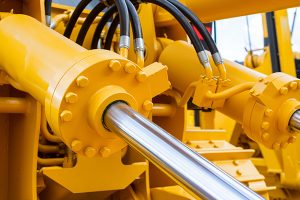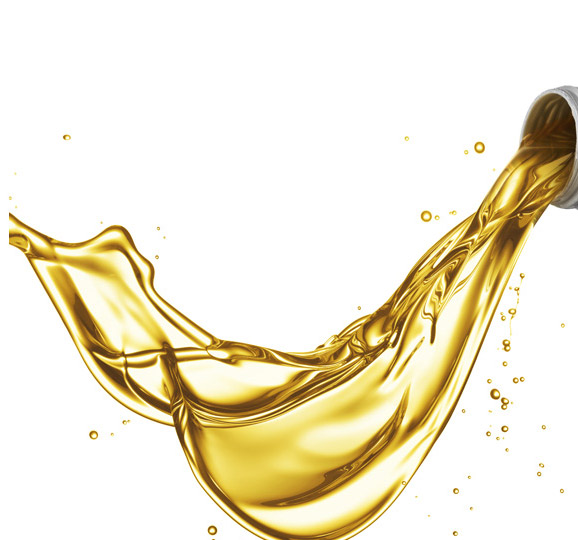Hydraulic systems are used in everything from forklifts to elevators, as well as most construction equipment, including bulldozers, backhoes and loaders, but what is hydraulic fluid and what does it do? That’s what we’ll cover in this post.
How hydraulic systems work
Hydraulic systems work by applying pressure to the confined hydraulic fluid and forcing it to flow in a prescribed direction. The pressure applied to the fluid at one point is transmitted to all points the fluid reaches.
Hydraulic fluid not only provides the medium for hydraulic power, it is also responsible for lubricating hydraulic components and protecting them from wear, rust and contaminants.
Hydraulic systems can look complex and intimidating, but most are relatively straightforward, consisting of the following parts:
- Reservoir
- Pump
- Hoses
- Valves
- Pistons or hydraulic motors
Reservoir
The hydraulic system’s reservoir holds the hydraulic oil, providing time for the transferring of heat, and a place for contaminants, including water, to settle.
Pump
The hydraulic system’s pump produces the fluid flow that creates pressure.
In most cases, it is often the most expensive part in the system. Hydraulic fluids are subjected to pump tests to prove their ability to protect pumps under normal operating conditions.
Hydraulic systems can have many different types of pumps, but the three most common include…
- Gear – often found on lower-pressure systems and are relatively simple and reliable. Although variations exist, a good example is an automotive oil pump.
- Vane – common on mobile equipment and can be variable or constant displacement.
- Piston – can be found on higher-pressure applications and are more complex and sensitive to contamination than vane or piston pumps.
Hoses
Hoses carry hydraulic pressure and flow to various components, and are perhaps the weakest link in any hydraulic system. Maintenance is often ignored until a problem develops. Hoses fail due to heat, cold, repeated flexing, physical damage and exposure to the elements.
Valves
Valves control the route of the hydraulic flow within the system, sending flow and pressure to components to operate them. Pulling a lever back may route fluid to one side of the hydraulic system, causing it to extend a piston, while pushing it forward may cause it to retract.
Varnish presents a major problem with valves, causing them to stick or not allowing them to seal properly.
Pistons/hydraulic motors
Pistons and hydraulic motors convert the hydraulic flow and pressure into work.
Pistons provide linear motion, allowing bulldozer blades to lift and backhoe buckets to tip, while motors convert hydraulic flow and pressure into rotational force, allowing drills to operate.
Common issues associated with pistons and hydraulic motors are internal or external leakage. External leakage results in loss of fluid and possible contamination, while internal leakage results in lost efficiency. For example, a bottle jack with its valve only partially closed requires furious pumping to lift an object off the ground and won’t be able to keep it there.
Hydraulic fluid
Zinc-containing hydraulic oil is a commonly used hydraulic fluid, while other applications call for zinc-free hydraulic oil, motor oil or transmission fluid.
Hydrostatic hydraulic oil is required when the fluid must also operate the hydrostatic transmission, biodegradable hydraulic oil is often required in environmentally sensitive areas and some applications require fire-resistant hydraulic oils.
Each type of hydraulic fluid has unique characteristics, and it’s important to understand what’s required for specific applications. The equipment operator’s manual will usually recommend viscosities for the ambient temperatures in which the machine is operated.
AMSOIL synthetic hydraulic fluids solve hydraulic problems
Heat reduction
The synthetic construction of AMSOIL synthetic hydraulic oils can reduce heat in hydraulic systems, leading to…
- Better viscosity retention
- Less varnish buildup and oxidation
- Reduced component wear (including hoses)
- Longer seal life
- Better overall system performance
Cold-weather performance
AMSOIL synthetic hydraulic oils have much better cold-temperature characteristics than many petroleum oils.
Because mobile equipment generally sits out in the elements while on a job site, conventional hydraulic oils can thicken in the cold and lead to damage such as excessive pump wear due to cavitation, blown hoses, broken shafts or extended warm-up times that waste fuel. AMSOIL synthetic hydraulic oil helps reduce or eliminate many of these issues.
All-season functionality
To eliminate some of the problems associated with temperature changes, many mobile-equipment owners switch viscosities with the seasons. They may run an ISO 22 viscosity hydraulic oil in the winter and switch to an ISO 32 or 46 fluid in the summer.
AMSOIL synthetic hydraulic oils are high-viscosity-index formulations that can eliminate the need for seasonal changes. It’s possible to run an ISO 32 or ISO 46 successfully year-round in all but the most extremely cold conditions.
Hose-life preservation
Cold and heat wreak havoc on hoses and seals. Cold, thick fluid can cause pressure spikes, while extremely hot fluid breaks down hoses and seals over time. The superior cooling and flow properties of AMSOIL synthetic hydraulic oils help preserve hose integrity.









Comments
Share: